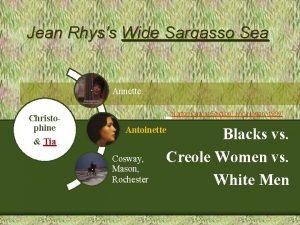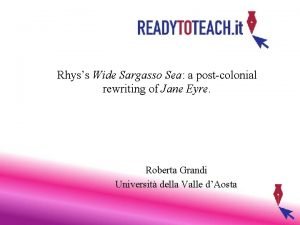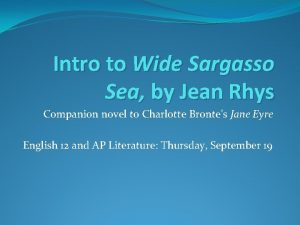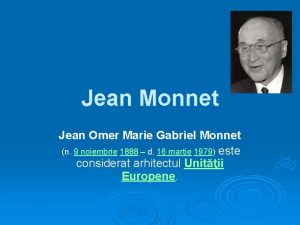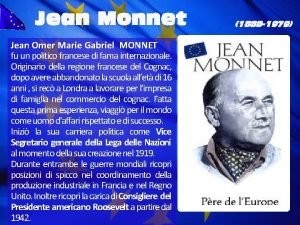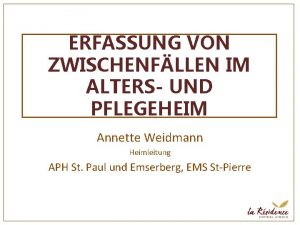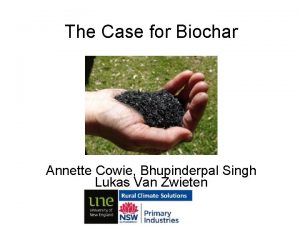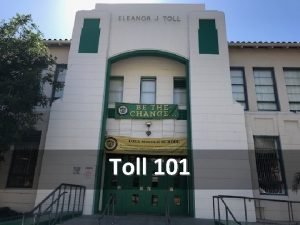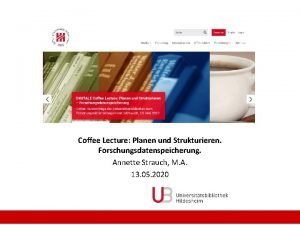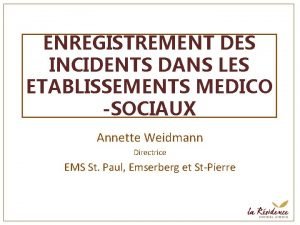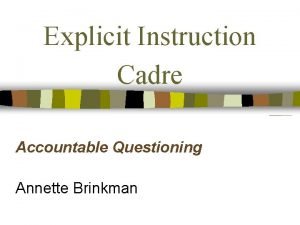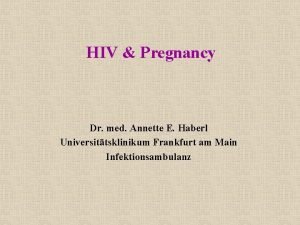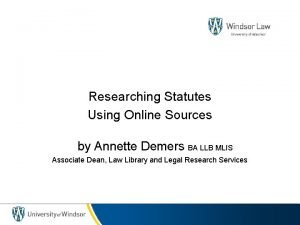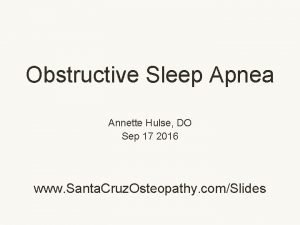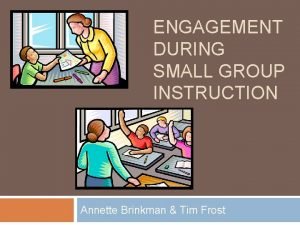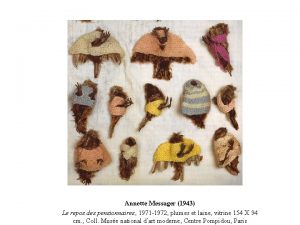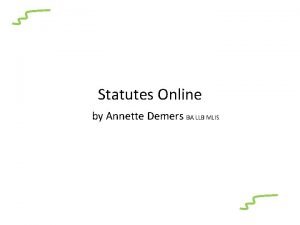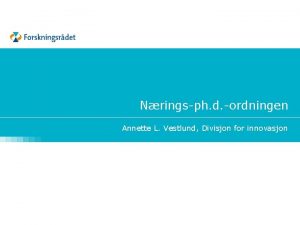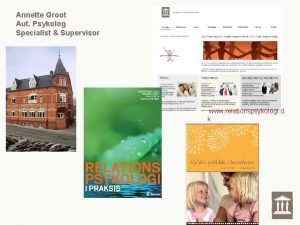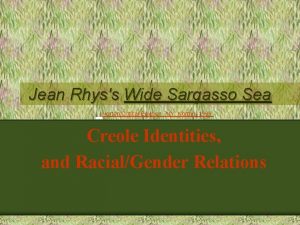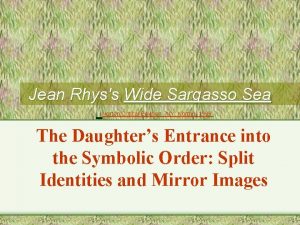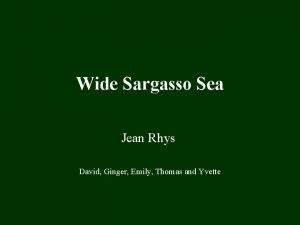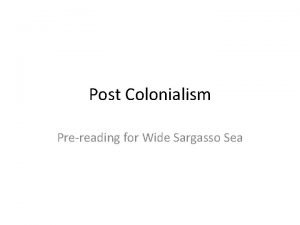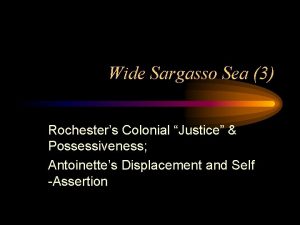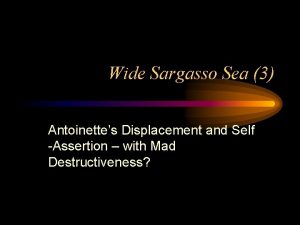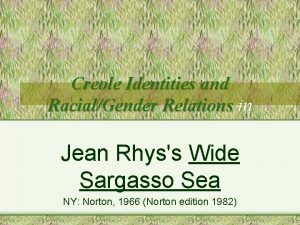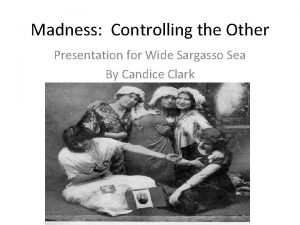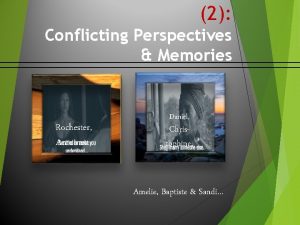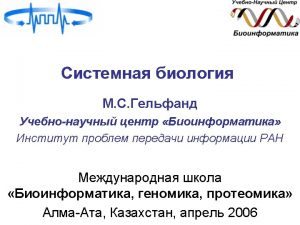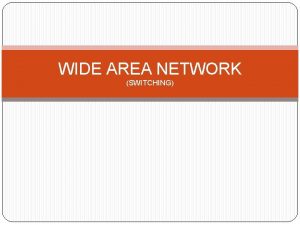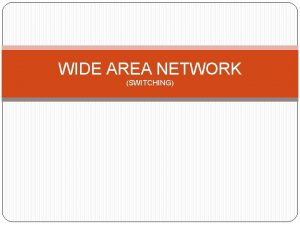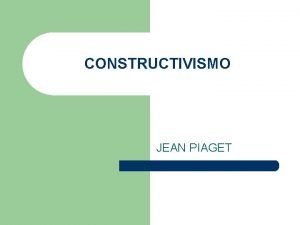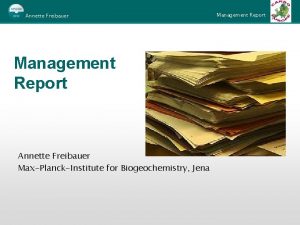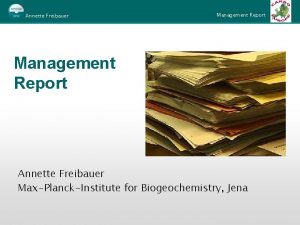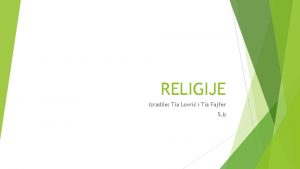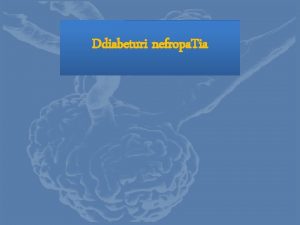Jean Rhyss Wide Sargasso Sea Annette Christophine Tia








![2. Pre-View: Why Is Bertha Mad? • Or—is she really mad? [Third dream]… But 2. Pre-View: Why Is Bertha Mad? • Or—is she really mad? [Third dream]… But](https://slidetodoc.com/presentation_image/5cb5d030e095d5977b2b42c69f50a1ba/image-9.jpg)

























- Slides: 34

Jean Rhys's Wide Sargasso Sea Annette Christophine & Tia Antoinette Cosway, Mason, Rochester Norton Critical Ediction. NY: Norton, 1999. Blacks vs. Creole Women vs. White Men

Outline • • • Wide Sargasso Sea: General Introduction & Questions Jean Rhys and Social Background Part I: Antoinette’s Relations to Annette, Christophine and Tia Her Personality 1) Annette: a) The Creole Identities of Annette; b) Annette as a Woman; c) madness Gender+Race 2) Antoinette: a) loss of mother; b) as a creole (loss of Tia); 3)Mr. Mason & convent 3) Antoinette’s personality 4) Symbols

WSS: Settings • Part I: (Martinique), Jamaica: Coulibri estate, near Spanish Town Part II: Granbois, Dominica, Part III: “Great House” England

Plot and Structure • Part I: Antoinette's Childhood – – Isolation after Mr. Cosway’s death and the Emancipation; – The mother’s re-marriage to Mr. Mason; – The riot; – Antoinette in the convent. • Part II: Rochester and Antoinette – Upon arrival, R tries to adjust, writes letters to his father; relations between A & R. – Daniel’s letter and the letter from England. – Antoinette’s taking action – Leaving for England. • Part III: Antoinette in England

Characters in Two Patriarchal Societies Mr. Cosway Pierre Mr. Mason Richard Father I/He (“Rochester”) Daniel Sandi Annette Aunt Cora Antoinette An English man

The Creole Family & the Blacks Cosway—Annette Alexander Daniel Pierre Mother St. Justine Sandi ----Antoinette—husband----Amèlie (Bertha) (Rochester) Christophine Tia Godfry Sass Mannie Baptiste…

Central Questions: Whence comes the Mad Woman in the Attic? • Part I: How does Rhys characterize Antoinette? What are the causes for her personalities? – Creole identity and Mother-daughter relationship; – childhood experience; – Convent education (Part II: How does Rhys explain the problems between Antoinette and Rochester? How do the two of them write themselves into the British house. – their socio-historical context— 19 th Century Victorian/Colonial world? Race + Gender)

1. Review: What does “creole” mean? A. language: mixture of languages, esp. in Southern US and the Caribbean area. B. People 1). Orignal meaning: Native, local, ”pure”; 2). Native-born whites; (e. g. Antoinette in WSS; film 1— 54: 10) 3). Hybrid (mixed-blood)
![2 PreView Why Is Bertha Mad Oris she really mad Third dream But 2. Pre-View: Why Is Bertha Mad? • Or—is she really mad? [Third dream]… But](https://slidetodoc.com/presentation_image/5cb5d030e095d5977b2b42c69f50a1ba/image-9.jpg)
2. Pre-View: Why Is Bertha Mad? • Or—is she really mad? [Third dream]… But when I looked over the edge I saw the pool at Coulibri. Tia was there. She beckoned to me and when I hesitated, she laughed. I heard her say, You frightened? And I heard the man's voice, Bertha! All this I saw and heard in a fraction of a second. And the sky so red. Someone screamed and I thought, Why did I scream? I called 'Tia!' and jumped and woke. …Now at last I know why I was brought here and what I have to do. There must have been a draught for the flame flickered and I thought it was out. But I shielded it with my hand it burned up again to light me along the dark passage. Tia from Childhood

3. Book I: Antoinette’s Education -1. G 2 What Roles do Annette & Christophine play in A’s growth as a child? 2. G 3 Antoinette’s personality & her responses to losses (in the garden & her dream)? Her relations with Tia? (The meanings of “double” and mirror? ) 3. G 1 “Society”: Mr. Mason, Spanish Town & the convent school 4. G 4 -Connecting Images/symbols: Pool, scream, Tia, fire, glacis/balcony, Coco?

Sugar Cane Alley: Major Themes & Questions • Exploitation of the black laborers --examples --covered in Introduction 1. Education --Who gets educated and by whom? 1 -1 G 3 Jose vs. the other kids in the school system 1 -2 G 2 --Jose and Ma. Tine and Madouze 2. Cultural identities -- different senses of black/creole/white identities; what contrasts or oppositions are portrayed in the film? 2 -1 G 1 Carmen 2 -2 G 4 Leopold and the ending

Jean Rhys--Biographical Sketch • 8/24/1890 the daughter of a Welsh doctor and a white Creole mother (great grandfather’s house burned down) • 1907 -8 Attends the Perse School, Cambridge. • 1909 -10 Tours as a chorus girl. Abandoned by her lover. • 1919 Marries Jean Lenglet and moves to Paris. 29 Dec. , birth of a son who dies three weeks later. (–altogether 3 marriages, 2 children. )

Jean Rhys--Biographical Sketch • 1923 -24 Meets Ford Madox Ford. Husband in jail, affair with Ford. (ménage a trois--Ford, Stella Bowen, Jean)) • 1933 Divorce. • 1934 Marries Leslie Tilden-Smith. • 1945 TS dead. Begins work on Wide Sargasso Sea. • 1947 Marriage to Max Hamer. Disappears from the public scene. • 1966 WSS published.

Rhys: her characters’ and her self-identity • Her characters: , all drifting, unhappy, unstable, but with clear self-knowledge and understanding of others. – “I have no pride—no name, no face, no country. I don’t belong anywhere. ” (Good Morning, Midnight. ) • Rhys: Only returned to Dominica once in 56 years; • Rhys: . "I don't belong anywhere but I get very worked up about the West Indies. I still care. . . . " Jean Rhys - Women Writers: Voices in Transition (3/4)

Rhys: her self-identity • "Do you consider yourself a West Indian? " She shrugged. "It was such a long time ago when I left. " "So you don't think of yourself as a West Indian writer? " Again she shrugged, but said nothing. "What about English? Do you consider yourself an English writer? " "No! I'm not, I'm not! I'm not even English. " "What about a French writer? " I asked. Again she shrugged and said nothing. "You have no desire to go back to Dominica? " "Sometimes, " she said. Jean Rhys – on not being happy

Wide Sargasso Sea: General Introduction – (1) the Title • Sargasso Sea: The heart of the Bermuda Triangle is covered by the strangest and most notorious sea on the planet— the Sargasso Sea; so named because there is a kind of seaweed which lazily floats over its entire expanse called sargassum. (source) • signaling the wide division between Antoinette and Rochester and the race and gender entangled relationships in the Caribbean area.

FYI: Sargasso Sea • An oval-shaped area of the North Atlantic Sea, bordered by the Gulf Stream and encompassing Bermuda Islands. It is characterized by weak currents, very little wind, and a freefloating mass of seaweed called Sargassum. (textbook 1)

Rhys on Jane Eyre • "The creole in Charlotte Bronte's novel is a lay figure -- repulsive which does not matter, and not once alive which does. . For me. . . she must be right on stage. She must be at least plausible with a past, the reason why Mr. Rochester treats her so abominably and feels justified, and the reason why he thinks she is mad and why of course she goes mad, even the reason why she tries to set everything on fire, and eventually succeeds. . . " (Gregg 82; emphases added) • Q: Is Anntoinette then doomed to be mad? Couldn’t there be different endings? Is the novel too sad?

Rhys's Revision of Jane Eyre: Shift of Dates: • Jane Eyre -- towards the end of the novel reads a book published in 1808 Bertha confined in the attic in the first decade of the 19 th century. • WSS's time frame shifted to 1830's onwards: Emancipation Act 1833 Antoinette – born 1839 (p. 31), a year after the full emancipation; a child in the 1840's (Mark Ma. Watt qut in Gregg 83)

Rhys's Revision of Jane Eyre: Antoinette’s Fathers • Jane Eyre – Bertha—the child of Mason • Wide Sargasso Sea – – two fathers (Mason and Cosway), the old slave master and the new one. – more relatives (Sandi, Daniel, etc. ) and connections with the Caribbean blacks (Tia and Christophine)

Book I: Plot “Trouble Comes” Mother trying Disliked b/ Mother Horse dies Doctor’s diagnosis of Pierre Passivity & Garden w/ Tia Clothes Change New Luttrell Annette active again Dream dislike people Wedding Gossips at Spanish Town Argument & Riot Annette screams Pappy Hit by Tia W Aunt Cora Convent Dream

Backgrounds (1) on Race: • I. white masters, New & Old: – Mr. Luttrell and his death p. 9; old Cosway p. 17/28 – Christophine’s comment and the new Lutrell 15/26 – New masters after the Emancipation of slaves [Mr. Mason – purpose p. 17/30; changes brought to Coulibri 18; about the blacks p. 19/32] • II. White against creole – e. g. the town people’s gossip p. 17; Aunt Cora's husband 18 • III. Black against creole: – poor "white cockroaches" p. 13/23; white niggers p. 14; black Englishman and white burned like black 26/42 • IV. The position of obeah woman p. 12/21, 17/30

Background (2): Before and after the Emancipation Pre-Emancipation: racial and sexual exploitation. (e. g. Daniel) Post-Emancipation Problems: 1. Belated Compensation, 2. Importation of contract laborers 3. Annette’s distrust of Christophine, Godfry, and Sass’ leaving p. 12/21 4. Riot: The presentation of the black mob -- Mason’s seeing the blacks as “children” 21/35 -- Myra – everybody goes to hell (21); -- animal howling (p. 23), -- parrot killed = bad luck 25/43; -- the final confrontation, women crying 26.

Important Symbols • the garden imagery in Part I; • The fire scene and the burning of the parrot (25) • The dreams

Creole Women’s Positions: Annette: 1) multiple alienations of the creole —from the white people in the Spanish town (9; 17) —because she is Creole, from Martinique and poor; -- from the blacks (“they”) because she is former slave-owner and poor: pp. 10, 11 -- both Annette and Antoinette—seen as “white cockroaches” (13)/”white nigger” (14)

Creole Women’s Positions: Annette: -- 2) As a woman – a. Cosway: a womanizer; calls Daniel’s mother “sly boots” pp. 73 -74; halfway house p. 57; drinks himself to death b. Widowed –can only survive by marrying again. Antoinette (solitary life) Annette (planned and hoped) p. 10 -- marooned & her son 11 -- borrow a horse from the new Luttrells gay and a good dancer c. 2 nd Marriage: Worse, since Mason does not understand the racial relationship (19, 21)

Creole Women’s Positions: Annette: -- 3) as a creole woman a. Why does she care so much about the parorot Co. Co? 25/41 b. Antoinette’s account of what happened to Annette: 78 (also her sensual memories of the past 79); 80 -81

Creole Women’s Positions: Antoinette: (1) loss of motherly love • Her love rejected by Annette (11, 13, 15, 2829, ) • The mother cares more about Pierre 16; • Annette ashamed of her 15; • Being pushed away after her madness pp. 2829/48 • missing her mother in the convent 34/57; • The mother’s death 36/61

Creole Women’s Positions: Antoinette—to Christophine Antoinette: (2) Race Relations – a. Christophine: helpful but fearful – like a substitute mother; – feared by Antoinette 18 -- Combination of Catholicism and voodoo (Part II: 1. Antoinette’s seeking for help: p. 67, 68, 70 2. Put in jail once and may still be. P. 86)

Creole Women’s Positions: Antoinette –Tia as Friend? a. Antoinette and Tia – • friendship (13 -14), • divided by racial differences (27) b. The boy and the girl 29 -30/48 -49

Creole Women’s Positions: Antoinette the second refuge in the convent –dissociated from reality – Stories of the saint (beautiful and wealthy); – no looking glass care taken in maintaining beautiful mages of femininity ; p. 32 -33; – images of the nations vs. the mother to be forgotten; 33/55 – A place of sunshine and of death. Pp. 33 -34

Creole Women’s Positions: Antoinette (& Annette) a. Imagery: Garden – – the biblical myth of the garden--(11) associated with snake and forest b. Imagery: Mirror and Double – Annette 10; p. Antoinette & Tia; the convent

Antoinette’s personality: 5 examples 1. Self-protection in Childhood: e. g. the horse p. 10; garden 13; 16 2. Sense of danger in the recurrent dreams pp. 15, 27, 36 3. Insecurity -- Attempt to turn down the marriage p. 46; 4. [the two rats & the moon p. 49 – death impulse p. 54] Insecure; in lack of a firm sense of identity; (lack of love, fear of others’ and society’s criticism, feeling excluded. ) Fatalistic (fear of “madness” as a hereditary trait) childhood as a creole woman

Next Week • Book II
 Annette in wide sargasso sea
Annette in wide sargasso sea Annette cosway
Annette cosway Wide sargasso sea summary
Wide sargasso sea summary Extreme wide shot
Extreme wide shot Dom
Dom Map of red sea crossing
Map of red sea crossing Jean monnet jean-gabriel monnet
Jean monnet jean-gabriel monnet Jean omer marie gabriel monnet
Jean omer marie gabriel monnet Sea stack diagram
Sea stack diagram Yellow sea and east china sea
Yellow sea and east china sea Hydra anemone
Hydra anemone Marlin symbolism
Marlin symbolism Led soldiers across hellespont into anatolia
Led soldiers across hellespont into anatolia Annette thomas
Annette thomas Annette gregg
Annette gregg Annette weidmann
Annette weidmann Annette cowie
Annette cowie Lerna amiryans
Lerna amiryans Annette logineo
Annette logineo Annette strauch
Annette strauch Annette weidmann
Annette weidmann Annette buchanan
Annette buchanan Annette brinkman
Annette brinkman Annette redmond
Annette redmond Annette pol
Annette pol Annette haberl
Annette haberl Annette downey
Annette downey Annette demers
Annette demers Santa cruz central sleep apnea
Santa cruz central sleep apnea Annette brinkman
Annette brinkman Les pensionnaires annette messager
Les pensionnaires annette messager Annette demers
Annette demers Annette westin
Annette westin Annette schermer
Annette schermer Annette groot
Annette groot
